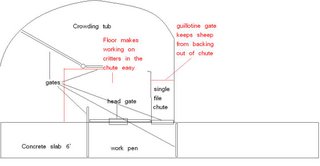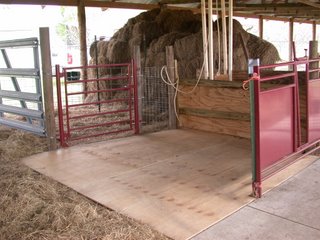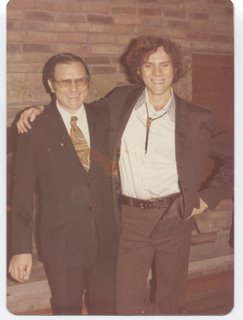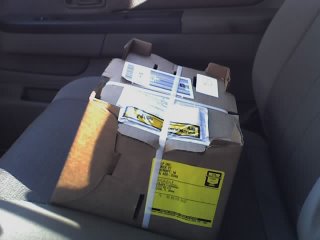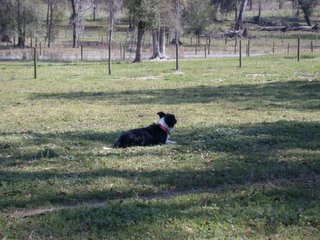Cow hay is usually grass hay in big round bales. What this term really means is that the hay is not good enough to be horse hay. It could be moldy, weedy, or old. Cows will eat most anything.
Horse hay is usually in small square bales. Grass hay can be horse hay, but it must be first rate grass hay, fresh, weed free, and not rained on.
Ocala Florida is just south of here. That area is much like Western Kentucky, lots of thoroughbred racehorses behind board fences and housed in barns that prosperous people would be proud to call home. Price is not an issue with hay for such horses, but it must be top quality. Very few of these horse farms produce their own hay.
Commercial Production
I’ve had a chance to observe how a commercial hay operation runs because one is located just across that road from our place. Fields are planted, in this case with Bermuda grass and treated with lime and fertilizer as needed. As many as five cuttings a year can be made, if rain is timely and hurricanes stay away. One year in five everything goes right.
Putting up hay here is a mad race to beat the rain. The window is always small and uncertain. During the summer we get an afternoon thunderstorm most days. No one can make hay in 24 hours. Across the road they can have hay in the barn 48 hours after it is cut.
This takes a small fortune in equipment. They cut with a huge mower conditioner late in the day. Before noon next day they are in the field with hay tedders, implements that fluff up the hay to make it dry faster. They usually have more than one of these in the field at a time. Early the second day the tedders are back.
They bale the outside and near any tree islands with a round baler. A very large tractor has a set of wheel rakes on the front and a big round baler behind. It does the whole job in one pass. This is used as cow hay, presumably because the edges of the field contain too many weeds to make horse hay.
The rest of the field is worked with three tractors at the same time. One pulls a wheel rake and the other two pull small square balers.
Behind each baler is and accumulator, a trailer like device that, as the name implies, accumulates a group of bails (nine I think) and then sets them off in a neat stack.
Late in the day a big semi truck comes in and the bale stacks are loaded on to it with a tractor that has a special front loader attachment.
If it rains at any point, work stops. When it dries out everything is put up in big round bales, cow hay, all of it.
Shares
For a small producers like me it is obviously not practical to produce hay this way. Most small holders try to make a deal on shares. This is where you contract with someone to come and bale your ground with his equipment and then take a share of the crop.
It is getting more and more difficult to find a deal like this that is good for both parties. For this to be profitable for the guy doing the baling it needs to be pretty close to what was described above in scale and quality. I talked about it with my neighbor across the road and he was not at all interested. My fields are too small and my grass wouldn’t give the sort of yield he needed (Pensacola Bahia). It would take him too much time to produce too little crop.
Unless you know someone who wants to do you a favor, the best you can hope for is to hire a custom operator, not on shares but some price per bale, that will come when they can get there. There is little chance that they will get to you just when the grass is at exactly the right stage of growth and when the rain holds off for a spell. The best you can hope for is cow hay, probably not very good cow hay, and fairly expensive to boot.
There is also the risk that your man will just not be able to get to you after all. He may have mechanical problems, the weather could be too wet, or he may have just made more promises than he could keep. Then you have rank tall grass up to your ears and no hay at all.
Just buy it
Most farms my size just buy hay. They have cattle so they buy cow hay. They also use stockpiled forage and do whatever else they can to make the pasture last as long as possible. This works but even so the cattle will have lost quite a bit of condition by spring.
I have mostly sheep and only a few head of cattle. I need something better than cow hay. Up till now I’ve been using supplemental grain to make up the difference. I could have bought horse hay instead. The problem with this is that it is expensive. Grain is not cheap here; it must be shipped all the way from the Midwest. Shelled corn costs about 10 cents a pound, $5.00 for a 50-pound bag. Horse hay costs about $5.00 a bale.
Even when purchasing feed, I still need to do something with all that grass. When the grass grows, it grows much faster than the animals can eat it. To graze off all the grass at peak growth would take a stocking rate close to that of a commercial feedlot. I don’t even want to think about paying the off-season feed bill for a mob like that.
Typically the extra grass is cut and left to rot. This must either be hired or done. The first year here we hired it done. Last year I bought a small farm tractor and did it myself.
Do it yourself
I did all sorts of research on how to make hay in smaller quantities for less money than is done commercially.
I looked into loose hay. I read articles in old issues of Mother Earth News (from the early 70’s) that described how to cut the roadside ditch with a scythe and stuff the clippings into an 55 gallon drum to form a bale.
I came to the conclusion that if I have unlimited money for equipment I don’t need much labor. If I have unlimited labor I don’t need much equipment or money. I don’t know about anyone else, but I don’t have unlimited anything.
I’ll do it myself
As I mentioned before, I bought a small farm tractor last year. It is used for all sorts of things aside from making hay, but I’m using it for hay as well. It is a 20-horse power (17 PTO horse power) diesel with four-wheel drive. It is Japanese built and about 15 years old. Anything smaller would be a lawn mower. When I bought it I also got a rotary cutter (Bush Hog, but not that brand name).
Any implement dealer will tell you that this tractor is too small to run a hay baler. They will also tell you that a hay baler costs something like $20,000. Both these things are true if we are talking about a new hay baler.
When I was growing up my dad had an old 1950’s International tractor that didn’t have too many more horsepower than my tractor does. He also had an old square baler (I don’t remember the brand) that didn’t even use the tractor PTO, it had it’s own small gasoline engine. The neighbor used a similar baler with a Ford 8n, which is smaller than the tractor I have now.
So I went and asked some old friends about this. By old friends I don’t mean I’ve known these guys a long time, I mean they are old, both in their late seventies. Both had farmed most of their lives and enjoyed sharing what they know. They said that I had plenty enough tractor to run one of the older model balers, even a PTO model. When I asked how it would make it through a real thick cutting, they told me to “Go real slow”.
They said they were still common enough even if they had not been used for a while. They agreed to look at any prospects I found, they knew the difference between and old machine that had some life left in it and junk, I wasn’t sure I could tell.
 I found one and bought it. It needed some work but my friends assured me it was sound. They helped me fix it up, mostly a matter of greasing things and lubricating lots of dried out chains. It got a few things welded on and the knot tiers adjusted up. By the time this all got done, last summer was gone, but I still put up about 250 bales at the very end of the year.
I found one and bought it. It needed some work but my friends assured me it was sound. They helped me fix it up, mostly a matter of greasing things and lubricating lots of dried out chains. It got a few things welded on and the knot tiers adjusted up. By the time this all got done, last summer was gone, but I still put up about 250 bales at the very end of the year.Here are some of the details.
To make hay this way you need:
1) A tractor
2) Some way to cut the grass
3) A rake to form windrows
4) The baler.
I paid $1000 for the baler. I spent about $300 more getting it fixed. I’m not counting the time I spent on this myself, and the old guys helping me were very generous with their time as well. I did pay them some, but not near what they were worth.
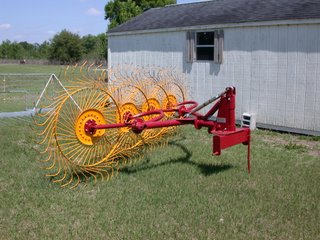 When I bought the baler the seller included a ground driven side delivery rake for free. He said he had never used it, didn’t know if it could be fixed, but it was free. We drug it home and tried to fix it, but shouldn’t have bothered; it was junk. We would weld something, go half a lap around the field and break something else. In the end I bought a brand new wheel rake for about $800. No worries.
When I bought the baler the seller included a ground driven side delivery rake for free. He said he had never used it, didn’t know if it could be fixed, but it was free. We drug it home and tried to fix it, but shouldn’t have bothered; it was junk. We would weld something, go half a lap around the field and break something else. In the end I bought a brand new wheel rake for about $800. No worries.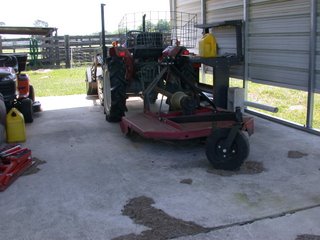 There is no-end of tools that can be used to cut grass. Traditionally hay is cut with a cycle bar mower. Now days drum mowers are more common. One mower, the rotary (bush hog) type mower is what I already had and most everyone who has a tractor seems to own.
There is no-end of tools that can be used to cut grass. Traditionally hay is cut with a cycle bar mower. Now days drum mowers are more common. One mower, the rotary (bush hog) type mower is what I already had and most everyone who has a tractor seems to own. A rotary mower is not good for hay because it chops the grass up into pieces that are too small to make good hay. The body of the mower is a steel box and the grass is held inside the box like food in a kitchen blender and whacked up into tiny pieces before it gets spit out the rear of the mower.
What I did was cut one side out of the body of the mower. On my mower the blade spins counter clockwise. I cut the left side (facing the front of the tractor) off the box that forms the body of the mower. I knew to do this and that it would work because this is what we used on my dads farm when I was growing up. It cuts the grass and immediately spits it out before it gets chewed up too much. It can then be raked and baled without problem. This is just for grass hay; I don’t know how it would work with clover or alfalfa.
This is older equipment. I do not expect it to be as trouble free as new equipment would be. For my farm though it is appropriate. I have about 30 acres of pasture and need about 1000 bales a year. My land is contiguous so there is no need for me to transport equipment over the roadways.
So now I can make my own hay. I have a little over $2000.00 in equipment not counting the tractor and mower. Buying $2000 worth of good hay in small square bales would not quite fill my barn. Baling the hay myself is a lot of work of course, but this way I know what I have. I know where it came from and how it was grown. I know for sure that it has not been rained on.
So to paraphrase my old friend, the way to make hay without spending a jillion dollars on equipment or working like a gang of coolies is to “Just go real slow”.
